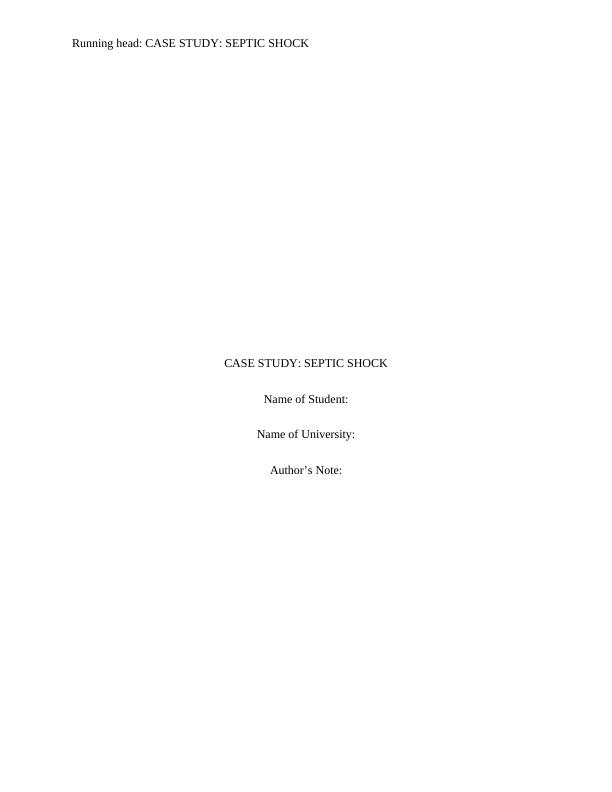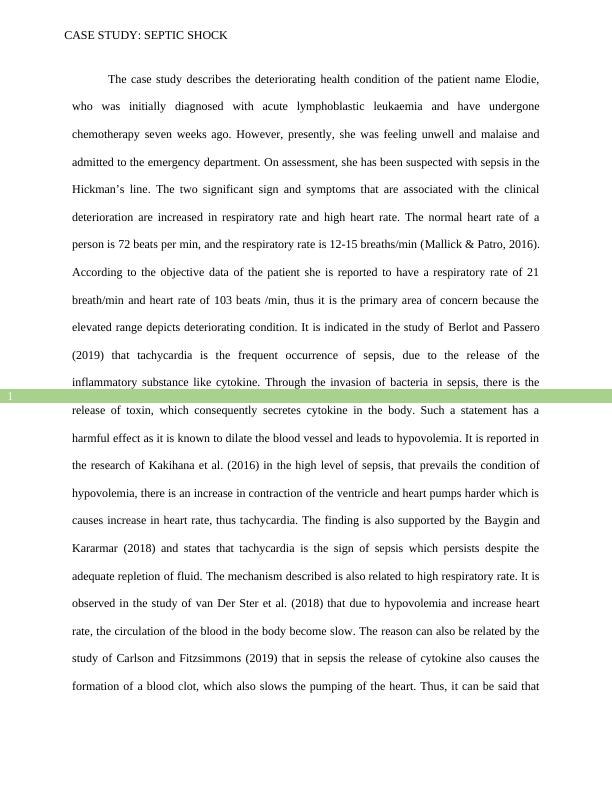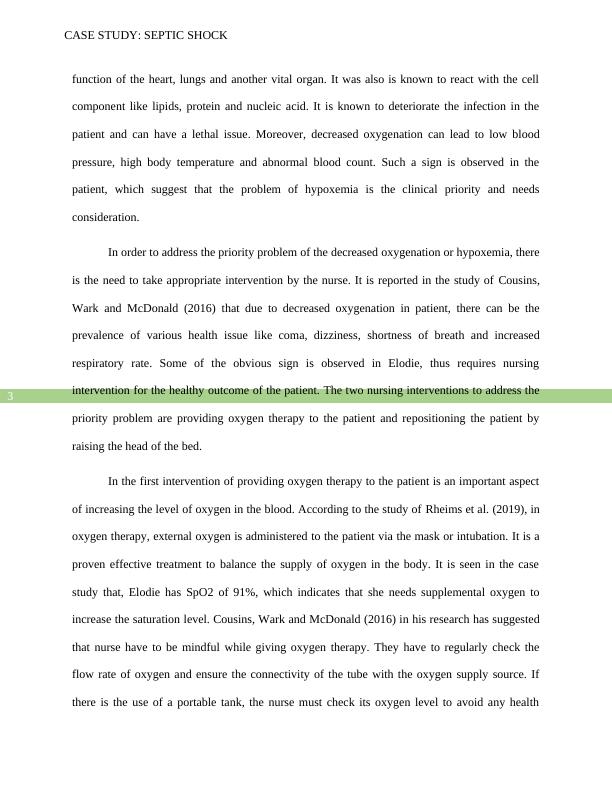Case Study of Elodie, a Patient with Acute Lymoblastic Leukaemia
Added on 2022-10-17
11 Pages3399 Words395 Views
Running head: CASE STUDY: SEPTIC SHOCK
CASE STUDY: SEPTIC SHOCK
Name of Student:
Name of University:
Author’s Note:
CASE STUDY: SEPTIC SHOCK
Name of Student:
Name of University:
Author’s Note:

CASE STUDY: SEPTIC SHOCK
1
The case study describes the deteriorating health condition of the patient name Elodie,
who was initially diagnosed with acute lymphoblastic leukaemia and have undergone
chemotherapy seven weeks ago. However, presently, she was feeling unwell and malaise and
admitted to the emergency department. On assessment, she has been suspected with sepsis in the
Hickman’s line. The two significant sign and symptoms that are associated with the clinical
deterioration are increased in respiratory rate and high heart rate. The normal heart rate of a
person is 72 beats per min, and the respiratory rate is 12-15 breaths/min (Mallick & Patro, 2016).
According to the objective data of the patient she is reported to have a respiratory rate of 21
breath/min and heart rate of 103 beats /min, thus it is the primary area of concern because the
elevated range depicts deteriorating condition. It is indicated in the study of Berlot and Passero
(2019) that tachycardia is the frequent occurrence of sepsis, due to the release of the
inflammatory substance like cytokine. Through the invasion of bacteria in sepsis, there is the
release of toxin, which consequently secretes cytokine in the body. Such a statement has a
harmful effect as it is known to dilate the blood vessel and leads to hypovolemia. It is reported in
the research of Kakihana et al. (2016) in the high level of sepsis, that prevails the condition of
hypovolemia, there is an increase in contraction of the ventricle and heart pumps harder which is
causes increase in heart rate, thus tachycardia. The finding is also supported by the Baygin and
Kararmar (2018) and states that tachycardia is the sign of sepsis which persists despite the
adequate repletion of fluid. The mechanism described is also related to high respiratory rate. It is
observed in the study of van Der Ster et al. (2018) that due to hypovolemia and increase heart
rate, the circulation of the blood in the body become slow. The reason can also be related by the
study of Carlson and Fitzsimmons (2019) that in sepsis the release of cytokine also causes the
formation of a blood clot, which also slows the pumping of the heart. Thus, it can be said that
1
The case study describes the deteriorating health condition of the patient name Elodie,
who was initially diagnosed with acute lymphoblastic leukaemia and have undergone
chemotherapy seven weeks ago. However, presently, she was feeling unwell and malaise and
admitted to the emergency department. On assessment, she has been suspected with sepsis in the
Hickman’s line. The two significant sign and symptoms that are associated with the clinical
deterioration are increased in respiratory rate and high heart rate. The normal heart rate of a
person is 72 beats per min, and the respiratory rate is 12-15 breaths/min (Mallick & Patro, 2016).
According to the objective data of the patient she is reported to have a respiratory rate of 21
breath/min and heart rate of 103 beats /min, thus it is the primary area of concern because the
elevated range depicts deteriorating condition. It is indicated in the study of Berlot and Passero
(2019) that tachycardia is the frequent occurrence of sepsis, due to the release of the
inflammatory substance like cytokine. Through the invasion of bacteria in sepsis, there is the
release of toxin, which consequently secretes cytokine in the body. Such a statement has a
harmful effect as it is known to dilate the blood vessel and leads to hypovolemia. It is reported in
the research of Kakihana et al. (2016) in the high level of sepsis, that prevails the condition of
hypovolemia, there is an increase in contraction of the ventricle and heart pumps harder which is
causes increase in heart rate, thus tachycardia. The finding is also supported by the Baygin and
Kararmar (2018) and states that tachycardia is the sign of sepsis which persists despite the
adequate repletion of fluid. The mechanism described is also related to high respiratory rate. It is
observed in the study of van Der Ster et al. (2018) that due to hypovolemia and increase heart
rate, the circulation of the blood in the body become slow. The reason can also be related by the
study of Carlson and Fitzsimmons (2019) that in sepsis the release of cytokine also causes the
formation of a blood clot, which also slows the pumping of the heart. Thus, it can be said that

CASE STUDY: SEPTIC SHOCK
2
due to toxin and increased heart rate, lungs receive less amount of blood and gaseous exchange
mechanism become slow, which leads to increased respiratory rate. Therefore, the emergence of
two vital sign of increased heart rate and increased respiratory rate are indicative to a high level
of infection. Thus, it depicts the clinical deterioration of the health of the patient.
From the review of the case study, it can be said that the priority problem identified in
Eliode is the prevalence of hypoxemia which is referred to as a low level of oxygen in the blood.
According to the study of von Seth et al. (2017), it is inferred that patient who experiences septic
shock, the delivery of the oxygen is high. However, the oxygen extraction ratio in the body is
low. As the uptake of oxygen is depended on the supply of the oxygen over the wider range, in
the condition of sepsis, the bacterial invasion, slows the immune response due to which the
release of the inflammatory substance causes slow circulation of blood. It is seen in the case
study that the patient has SpO2 of 91%, which is low than the normal range and indicative of
decreased oxygenation. In the research of Goonasekera, Carcillo and Deep (2018), it is
highlighted that in sepsis, the heart is unable to pump sufficient blood and does not reach to the
lung for oxygenation. As a result of it, deoxygenated blood travels to the body and level of
oxygen in the blood become low. It is the severe consequence of sepsis patient as it can give rise
to various health issues like dizziness, coma or even death of the patient. Carhart-Harris et al.
(2015) have suggested in his research that decreased level of oxygen in the blood, can cause
insufficient transport of oxygen in the cell of the body. The function of the cells can be halted,
and normal metabolism of the body can lead to reverse reaction. In sepsis, there is an imbalance
between the supply and demand of oxygen, which thus leads to cellular dysfunction and failure
of the organ (Bjerkvig et al., 2016). In the oxidative stress condition, there is the production of
free oxygen radicals, which is regarded as the toxin of the body. It has the potential to impair the
2
due to toxin and increased heart rate, lungs receive less amount of blood and gaseous exchange
mechanism become slow, which leads to increased respiratory rate. Therefore, the emergence of
two vital sign of increased heart rate and increased respiratory rate are indicative to a high level
of infection. Thus, it depicts the clinical deterioration of the health of the patient.
From the review of the case study, it can be said that the priority problem identified in
Eliode is the prevalence of hypoxemia which is referred to as a low level of oxygen in the blood.
According to the study of von Seth et al. (2017), it is inferred that patient who experiences septic
shock, the delivery of the oxygen is high. However, the oxygen extraction ratio in the body is
low. As the uptake of oxygen is depended on the supply of the oxygen over the wider range, in
the condition of sepsis, the bacterial invasion, slows the immune response due to which the
release of the inflammatory substance causes slow circulation of blood. It is seen in the case
study that the patient has SpO2 of 91%, which is low than the normal range and indicative of
decreased oxygenation. In the research of Goonasekera, Carcillo and Deep (2018), it is
highlighted that in sepsis, the heart is unable to pump sufficient blood and does not reach to the
lung for oxygenation. As a result of it, deoxygenated blood travels to the body and level of
oxygen in the blood become low. It is the severe consequence of sepsis patient as it can give rise
to various health issues like dizziness, coma or even death of the patient. Carhart-Harris et al.
(2015) have suggested in his research that decreased level of oxygen in the blood, can cause
insufficient transport of oxygen in the cell of the body. The function of the cells can be halted,
and normal metabolism of the body can lead to reverse reaction. In sepsis, there is an imbalance
between the supply and demand of oxygen, which thus leads to cellular dysfunction and failure
of the organ (Bjerkvig et al., 2016). In the oxidative stress condition, there is the production of
free oxygen radicals, which is regarded as the toxin of the body. It has the potential to impair the

CASE STUDY: SEPTIC SHOCK
3
function of the heart, lungs and another vital organ. It was also is known to react with the cell
component like lipids, protein and nucleic acid. It is known to deteriorate the infection in the
patient and can have a lethal issue. Moreover, decreased oxygenation can lead to low blood
pressure, high body temperature and abnormal blood count. Such a sign is observed in the
patient, which suggest that the problem of hypoxemia is the clinical priority and needs
consideration.
In order to address the priority problem of the decreased oxygenation or hypoxemia, there
is the need to take appropriate intervention by the nurse. It is reported in the study of Cousins,
Wark and McDonald (2016) that due to decreased oxygenation in patient, there can be the
prevalence of various health issue like coma, dizziness, shortness of breath and increased
respiratory rate. Some of the obvious sign is observed in Elodie, thus requires nursing
intervention for the healthy outcome of the patient. The two nursing interventions to address the
priority problem are providing oxygen therapy to the patient and repositioning the patient by
raising the head of the bed.
In the first intervention of providing oxygen therapy to the patient is an important aspect
of increasing the level of oxygen in the blood. According to the study of Rheims et al. (2019), in
oxygen therapy, external oxygen is administered to the patient via the mask or intubation. It is a
proven effective treatment to balance the supply of oxygen in the body. It is seen in the case
study that, Elodie has SpO2 of 91%, which indicates that she needs supplemental oxygen to
increase the saturation level. Cousins, Wark and McDonald (2016) in his research has suggested
that nurse have to be mindful while giving oxygen therapy. They have to regularly check the
flow rate of oxygen and ensure the connectivity of the tube with the oxygen supply source. If
there is the use of a portable tank, the nurse must check its oxygen level to avoid any health
3
function of the heart, lungs and another vital organ. It was also is known to react with the cell
component like lipids, protein and nucleic acid. It is known to deteriorate the infection in the
patient and can have a lethal issue. Moreover, decreased oxygenation can lead to low blood
pressure, high body temperature and abnormal blood count. Such a sign is observed in the
patient, which suggest that the problem of hypoxemia is the clinical priority and needs
consideration.
In order to address the priority problem of the decreased oxygenation or hypoxemia, there
is the need to take appropriate intervention by the nurse. It is reported in the study of Cousins,
Wark and McDonald (2016) that due to decreased oxygenation in patient, there can be the
prevalence of various health issue like coma, dizziness, shortness of breath and increased
respiratory rate. Some of the obvious sign is observed in Elodie, thus requires nursing
intervention for the healthy outcome of the patient. The two nursing interventions to address the
priority problem are providing oxygen therapy to the patient and repositioning the patient by
raising the head of the bed.
In the first intervention of providing oxygen therapy to the patient is an important aspect
of increasing the level of oxygen in the blood. According to the study of Rheims et al. (2019), in
oxygen therapy, external oxygen is administered to the patient via the mask or intubation. It is a
proven effective treatment to balance the supply of oxygen in the body. It is seen in the case
study that, Elodie has SpO2 of 91%, which indicates that she needs supplemental oxygen to
increase the saturation level. Cousins, Wark and McDonald (2016) in his research has suggested
that nurse have to be mindful while giving oxygen therapy. They have to regularly check the
flow rate of oxygen and ensure the connectivity of the tube with the oxygen supply source. If
there is the use of a portable tank, the nurse must check its oxygen level to avoid any health

End of preview
Want to access all the pages? Upload your documents or become a member.
Related Documents
Case Study: The Deteriorating Patientlg...
|12
|3197
|1
Pediatric Septic Shock Introductionlg...
|11
|3111
|267
Pediatric Acute Lymphoblastic Leukemia Questions and Answers 2022lg...
|7
|1878
|14
BACHELOR NURSING ASSIGNMENT.lg...
|10
|2367
|294
Septic Shock: Symptoms, Nursing Interventions and Priority of Carelg...
|11
|2839
|202
Septic Shock Managementlg...
|12
|2815
|120
